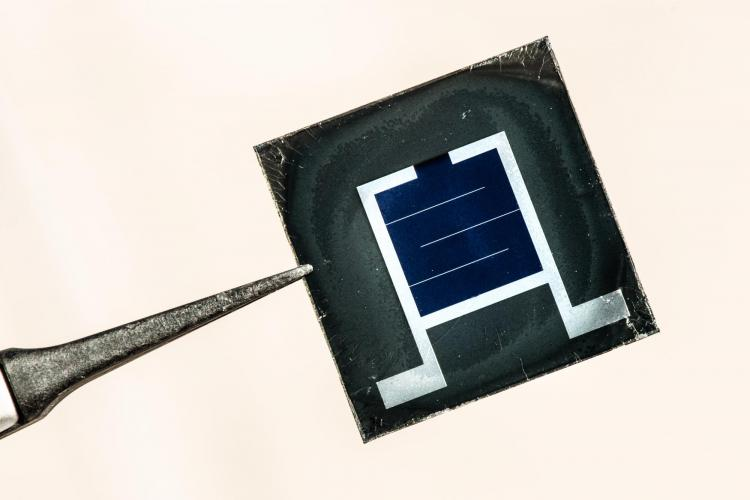Mar 6 2020
Solar power is gearing up for a brighter future. Scientists from the University of Colorado Boulder (CU Boulder) have recently developed a cost-effective solar cell by layering cells as well as by utilizing a special combination of elements. This solar cell has one of the highest power-conversion efficiencies so far.
 Perovskite/silicon tandem solar cells are contenders for next-generation photovoltaic technology, with the potential to deliver module efficiency gains at a minimal cost. Image Credit: Dennis Schroeder/NREL.
Perovskite/silicon tandem solar cells are contenders for next-generation photovoltaic technology, with the potential to deliver module efficiency gains at a minimal cost. Image Credit: Dennis Schroeder/NREL.
We took a product that is responsible for a $30 billion a year industry and made it 30% better. That’s a big deal.
Michael McGehee, Study Co-Author and Professor, Department of Chemical and Biological Engineering, University of Colorado Boulder
The study was recently published in the Science journal that elucidates the new technology.
For their experiment, the scientists used a perovskite solar cell—a kind of crystal structure developed to harvest a higher number of energy photons—and applied it over a silicon solar cell in the form of a layer. This silicon solar cell captures more numbers of photons in the spectrum’s infrared part. The spectrum is composed of radiant energy that cannot be seen but can only be felt as heat.
Together, the perovskite increases the efficiency of the silicon solar cell from 21% to up to 27%—raising it by a third.
For several years, silicon solar cells have been the norm in the solar power sector. However, contemporary silicon-based cells are capable of converting only 18% to 21% of the solar energy into usable electricity on average, and their maximum conversion efficiency is approximately 26.6%.
This implies that the installation cost of the solar cells is more than their purchasing cost, stated McGehee, a fellow in the Renewable & Sustainable Energy Institute.
The solar panels’ average efficiency is lower than the highest efficiency because even if a small, individual solar cell is exceptional, it will lose about 3% points upon applying across a huge panel—similar to a sports team only being as good as its average player.
However, if the overall efficiency is increased, it is not necessary to install a large number of panels to achieve the same amount of power. Placing another solar cell over an existing one dramatically enhances efficiency, and that is exactly what McGehee and his fellow scientists did.
An Affordable Secret Formula
Layering the solar cells to gain efficiency is not a new concept and has already been done by researchers. The concept, also called tandem or multi-junction solar cells, was initially introduced in the 1970s, and the world record for the efficiency of solar cells is already more than 45%.
But it came at a heavy price: $80,000 per square meter, because the solar cells were grown a single atomic layer at a time, producing one large, single crystal. This is perhaps not the cost that could be afforded by an average business or homeowner.
McGehee and his fellow team were the first to forge a new direction of layered solar cells, utilizing perovskites, the cost of which is a hundred times less.
The researchers started less than 10 years ago with the idea of utilizing less costly materials to be layered over the silicon, and they initially achieved an efficiency of around 13%. However, via technological advancements, the researchers were able to increase that number by more than two-fold. The team’s secret formula involves a special triple-halide alloy of iodine, bromine, and chlorine.
According to McGehee, an ideal bandgap exists in solar cells. This is the space that exists between energy levels present in a semiconductor, in which electrons jump and produce electrical energy.
Bromine can increase this bandgap, but when this element is utilized with iodine and subjected to light, it does not invariably remain in place. Earlier studies have attempted to utilize both iodine and chlorine together, but since these elements have varying particle sizes, a sufficient amount of chlorine could not be accommodated in the perovskite crystal structure.
However, by utilizing varying amounts of iodine, bromine, and chlorine, the scientists identified a new method to reduce the size of the crystal structure, thus enabling more amounts of chlorine to fit in—stabilizing and enhancing the efficiency of the solar cell.
Furthermore, perovskites are economical, do not require much energy to make, and can also be developed easily in the laboratory. Moreover, even after 1000 hours, or nearly 42 days, of intensive heat and light testing, the novel solar cells displayed only a minimal change in their initial efficiency.
With the solar power market rising about 30% every year, factors like longevity, cost, and efficiency are the main considerations for which innovative technologies will become the mainstream. Nevertheless, McGehee is hopeful about the potential of this layered, wide-bandgap solar cell.
Not only has it currently exceeded the highest efficiency of a silicon-only solar cell, “we believe it can take us over 30% efficiency and that it can be stable,” concluded McGehee.
Other authors of the study include Jixian Xu, co-first author and postdoctoral researcher; Jérémie Werner, postdoctoral researcher; and Daniel Witter, graduate student in Chemical and Biological Engineering at the University of Colorado Boulder.
Caleb Boyd is the study’s co-first author, visitor at the University of Colorado Boulder and NREL, and graduate student at Stanford University; and also scientists from Arizona State University, the National Renewable Energy Laboratory, and Stanford University.